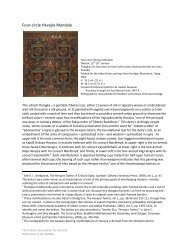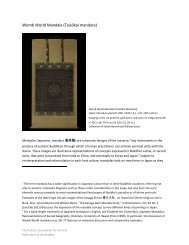Reflections of the Buddha - The Pulitzer Foundation for the Arts
Reflections of the Buddha - The Pulitzer Foundation for the Arts
Reflections of the Buddha - The Pulitzer Foundation for the Arts
Create successful ePaper yourself
Turn your PDF publications into a flip-book with our unique Google optimized e-Paper software.
Cube Gallery<br />
Vajrayāna Buddhism<br />
<strong>The</strong> spiritual practices and rituals <strong>of</strong> Vajrayāna Buddhism include <strong>the</strong> use <strong>of</strong> verse (mantra) to invoke a deity or<br />
to gain protection and <strong>the</strong> visualization <strong>of</strong> a vast array <strong>of</strong> celestial <strong>Buddha</strong>s and bodhisattvas, many embraced<br />
from early Buddhism and Mahāyāna Buddhism. In this gallery are three sculptures representing some <strong>of</strong> <strong>the</strong><br />
most important bodhisattvas, along with three thangkas (portable paintings or hanging banners). Thangkas<br />
<strong>of</strong>ten portray a divinity’s cosmos or circle (mandala) as an architectural plan with gates and various levels leading<br />
to central pinnacles. Such Vajrayāna objects aid meditation and trance induction that connect <strong>the</strong> viewer<br />
with sanctity in <strong>the</strong> universe and within oneself, bringing enlightenment closer.<br />
11. Four Mandalas (dkyil-‘khor), 18th century<br />
Tibet; thangka; colors on cotton, mounted on<br />
silk brocade; 31¾ x 24 in.; <strong>The</strong> Nelson-Atkins<br />
Museum <strong>of</strong> Art, Kansas City, Missouri,<br />
Bequest <strong>of</strong> Joseph H. Heil, 74-36 /16<br />
Practioners wishing to receive <strong>the</strong><br />
blessing <strong>of</strong> an extended lifespan <strong>of</strong>ten<br />
meditated on <strong>the</strong> figure at <strong>the</strong> center <strong>of</strong><br />
this thangka, Amitāyus (<strong>the</strong> name given to Amitābha in<br />
his manifestation as <strong>the</strong> bestower <strong>of</strong> longevity). Colored<br />
red, he sits in a beautiful landscape on a lotus throne in<br />
meditation holding a vase containing <strong>the</strong> elixir <strong>of</strong> immortality.<br />
On ei<strong>the</strong>r side <strong>of</strong> him are lamas, Tibetan teachers <strong>of</strong><br />
<strong>the</strong> Dharma, who sit in foliage that bears fruit in <strong>the</strong><br />
<strong>for</strong>m <strong>of</strong> <strong>the</strong> Three Buddhist Jewels, representing <strong>the</strong><br />
<strong>Buddha</strong>, <strong>the</strong> Dharma, and <strong>the</strong> San� gha.<br />
12. Four-circle Hevajra Mandala (Kye-ba Rdo-rje<br />
dkyil-‘khor), 15th or 16th century<br />
Tibet; thangka mounted as an album leaf; ink<br />
and colors on linen; 21 x 17½ in.; Harvard<br />
Art Museums / Arthur M. Sackler Museum,<br />
Paul Bernat Fund, 1967.8<br />
This mandala helps <strong>the</strong> practitioner<br />
visualize <strong>the</strong> union <strong>of</strong> <strong>the</strong> male and female principles <strong>of</strong><br />
compassion and wisdom, respectively. This integrative<br />
process <strong>of</strong> opposites lies at <strong>the</strong> heart <strong>of</strong> Vajrayāna practice.<br />
By recognizing opposites as psychological distortions<br />
within oneself, <strong>the</strong>ir power over you is lessened and your<br />
path to enlightenment is accelerated.<br />
42<br />
13. Acala Candamaharosana (Budong Mingwang),<br />
“<strong>The</strong> Immovable One,” One <strong>of</strong><br />
<strong>the</strong> Five Great Wisdom Kings, 1764<br />
China, Qing dynasty, 1644 – 1912; kesi thangka<br />
mounted as a hanging scroll; silk in kesi tapestry<br />
weave with some details painted on <strong>the</strong> surface in<br />
gold and light colors; 35¼ x 21¼ in.; Harvard Art<br />
Museums / Arthur M. Sackler Museum, Gift <strong>of</strong> Mr.<br />
and Mrs. Earl Morse, 1958.8<br />
This tightly woven tapestry depicts Acala surrounded by<br />
four o<strong>the</strong>r wrathful deities. Terrifying deities are <strong>of</strong>ten<br />
visual metaphors <strong>for</strong> inner states that block enlightenment,<br />
such as anger, greed, fear, passion, and ignorance.<br />
Acala holds a sword and a lasso, evidence <strong>of</strong> his abilities<br />
to cut through obstacles, snare you, and bring you closer<br />
to enlightenment.<br />
14. Bodhisattva Avalokiteśvara (Karunamaya),<br />
late 10th or early 11th century<br />
Nepal, Transitional period, c. 879 – 1200; gilt<br />
copper alloy with inlays <strong>of</strong> semiprecious stones;<br />
26¾ x 11½ x 5¼ in.; Asia Society, New York:<br />
Mr. and Mrs. John D. Rockefeller 3rd Collection,<br />
1979.047<br />
Avalokiteśvara (Perceiver <strong>of</strong> <strong>the</strong> World’s<br />
Sounds) travels to all realms <strong>of</strong> <strong>the</strong> universe to deliver beings<br />
from suffering. He has a special mantra: Om Mani<br />
Padme Hum (“Hail <strong>the</strong> wish-fulfilling jewel and lotus”).<br />
This particular work is one <strong>of</strong> <strong>the</strong> earliest Buddhist sculptures<br />
to use semiprecious stone inlays, which became a<br />
distinctive feature <strong>of</strong> Himalayan sculpture. Sculptures<br />
like this one were highly revered in Tibetan monasteries,<br />
which helped spread <strong>the</strong>ir style to o<strong>the</strong>r parts <strong>of</strong> Asia,<br />
including Mongolia (see artwork 16).




